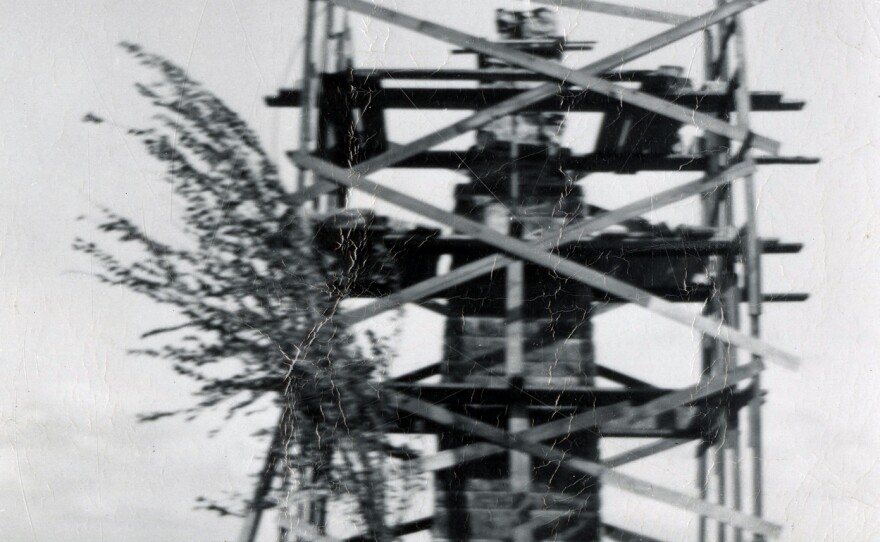
If you drive north on Cliff Avenue past the Smithfield plant in northern Sioux Falls, you might notice a stone obelisk on the top of a bluff above the Big Sioux River. It's a memorial to the pioneers of Minnehaha County. It is not a memorial to the so-called Amidon Affair. That bleak bit of local history is memorialized by a bronze plaque situated a few yards northeast of the obelisk. Given their proximity to one another, it's easy to confuse the two.
The Minnehaha County Historical Society secured the land and had the 25-foot tall obelisk erected in 1949. Like so many of the structures of old Sioux Falls, it is built from locally-mined quartzite. The original design blended the goals of honoring all of the county's pioneers and memorializing Judge Joseph B. Amidon and his son Willie, who were killed by a Native raiding party during the so-called Dakota War of 1962.
This is the inscription on a stone at the base of the Minnehaha County Pioneer Memorial obelisk:

Honors the early settlers who faced the harsh and lonely prairie, the ferocity of the elements, and the uncertainty of their fate in this new land between 1856 when Sioux Falls city was platted and 1889 when South Dakota achieved statehood. They built homes, farms and businesses and planted their family roots in Minnehaha county. This Sioux Quartzite obelisk was erected in their memory in 1949.
This is the inscription on the Amidon Affair marker, which was erected in 1991:

The 1862 Sioux Uprising, a result of unjust government treatment, claimed many Indian and non-Indian lives. Near this place on August 25, 1862, two of its victims, Judge Joseph B. Amidon and his son, William, were killed while making hay on their claim which was a mile north of their cabin in Sioux Falls.Amidon was a County Probate Judge, Treasurer and Commissioner appointed by Governor Jayne and the Territorial Legislature. When he and William failed to return home at sundown, Mrs. Amidon became alarmed and sought help from the Dakota Calvalry detachment in the village. A search was to no avail, but their bodies were found in the morning. Joseph died of a single bullet wound, William was riddled with arrows.George B. Trumbo brought their bodies back to the village. Later, Sgt. Jesse Buel Watson, Company A, Dakota Cavalry, reported, “we picked up the bodies and buried them in a cemetery…(on what is now)…North Duluth Avenue.”
In the opinion of John Renville and Joseph Laframboise, veteran fur traders and plainsmen, the Amidons were slain by members of the band of the warrior White Lodge. He was under orders from Chief Little Crow, Indian leader in the “Dakota War”, to drive white settlers from the Sioux Valley. Pure chance placed the Amidons in the path of White Lodge’s scouting party.
Two days later, orders came by courier from Governor William Jayne to abandon Sioux Falls and seek shelter at the Territorial Capitol at Yankton. Settlers and soldiers together hastily set out in a wagon train before sundown.
Following the settlers flight to Yankton, Sioux Falls remained abandoned until the establishment of Fort Dakota by federal troops in 1865, when settlement was resumed.
Joseph B Amidon was born in Connecticut in 1801. He came to Sioux Falls from Saint Paul, Minnesota, with his wife Mahala, son William and daughter Eliza, sometime before 1860.
The Pioneers Monument has fallen into disrepair in the past few years. The Minnehaha County Historical Society has been looking at ways to raise money for a maintenance project that would include tuck pointing of the masonry, improved lighting, and other improvements to the site.







